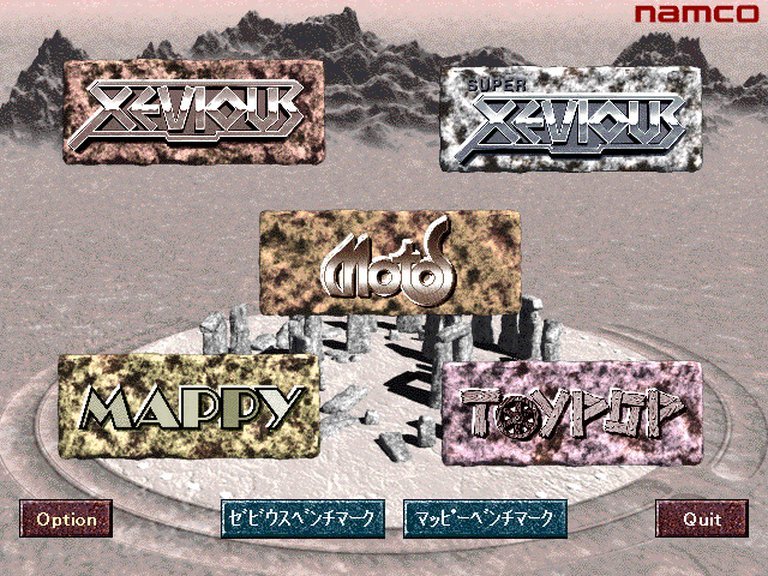- Release Year: 1997
- Platforms: Windows
- Publisher: Namco Limited
- Genre: Action, Compilation
- Gameplay: Arcade
- Average Score: 0/100

Description
Namco History Vol. 1 is a 1997 Windows 95 compilation game that preserves five classic Namco arcade titles from the golden age of gaming: Mappy, Xevious, Super Xevious, Motos, and Toy Pop. This collection offers players a nostalgic journey into early arcade history, faithfully recreating these iconic games with authentic gameplay and bundled with exclusive merchandise such as papercrafts and mousepads.
Where to Buy Namco History Vol. 1
PC
Namco History Vol. 1 Reviews & Reception
newqualitipedia.telepedia.net : The emulation is near arcade-perfect for all games.
Namco History Vol. 1: A Retrospective on a Pioneering Compilation
Introduction
In the mid-1990s, as the arcade industry faced decline, Namco sought to preserve its legacy by releasing Namco History Vol. 1, a compilation of five classic arcade games for Windows 95. Released on April 25, 1997, this collection was part of a broader effort to transition arcade classics to home consoles and PCs. Namco History Vol. 1 stands as a testament to Namco’s innovation during the golden age of arcade gaming, offering a curated selection of titles that defined an era. This review will dissect the compilation’s historical significance, gameplay mechanics, and lasting impact on gaming culture.
Development History & Context
Namco’s Legacy and the Arcade Boom
Namco, founded in 1955, became a powerhouse in the arcade industry with hits like Pac-Man (1980) and Galaga (1981). By the mid-1990s, the company faced challenges as home consoles gained popularity. Namco History Vol. 1 was part of a series of compilations aimed at preserving arcade classics for a new generation of gamers.
Technological Constraints and Emulation
The compilation was released for Windows 95, a platform that allowed Namco to leverage emulation technology to recreate arcade experiences. The games—Mappy, Xevious, Super Xevious, Motos, and Toy Pop—were ported with varying degrees of fidelity, reflecting the limitations of early PC emulation. While some titles retained their arcade charm, others suffered from performance issues or controls that didn’t translate well to keyboard and mouse.
The Gaming Landscape in 1997
1997 was a transitional year for gaming, with Final Fantasy VII and GoldenEye 007 pushing 3D graphics forward. Namco History Vol. 1 arrived as a nostalgic counterpoint, offering pixelated nostalgia in an era dominated by polygonal graphics. The compilation was marketed as a way for players to relive arcade experiences at home, a concept that would later be refined in Namco Museum series for consoles.
Narrative & Thematic Deep Dive
Mappy (1983)
A side-scrolling action game where players control a mouse named Mappy, tasked with stealing treasures from cats. The game’s whimsical premise and colorful visuals made it a standout in Namco’s lineup.
Xevious (1982) & Super Xevious (1984)
These shooters feature a sci-fi narrative where players pilot the Solvalou to defend Earth from alien invaders. The games introduced layered gameplay, requiring players to engage both air and ground targets, a mechanic that influenced later shooters like R-Type and Gradius.
Motos (1985)
A motorcycle racing game with a unique isometric perspective. Players navigate obstacle courses, avoiding hazards and collecting flags. The game’s physics and controls were ahead of their time, though the PC port struggled with responsiveness.
Toy Pop (1986)
A puzzle game where players clear blocks by matching colors. It predated Tetris in concept but lacked the same polish, making it a lesser-known entry in the compilation.
Gameplay Mechanics & Systems
Core Gameplay Loops
- Shooters (Xevious, Super Xevious): Players navigate vertically scrolling levels, destroying enemies and avoiding obstacles. The dual-layered combat (air and ground) added depth.
- Action (Mappy): Side-scrolling platforming with treasure collection and enemy evasion.
- Racing (Motos): Isometric racing with physics-based challenges.
- Puzzle (Toy Pop): Matching mechanics similar to Bejeweled.
Innovations and Flaws
- Emulation Accuracy: Some games suffered from input lag or graphical glitches, detracting from the arcade experience.
- Controls: Keyboard and mouse controls were clunky for action-heavy games, though joystick support helped.
- Difficulty: The games retained their arcade difficulty, which could be frustrating for modern players.
World-Building, Art & Sound
Visual Direction
The games featured pixel art that held up well, though the PC ports sometimes lacked the crispness of their arcade counterparts. Xevious’s scrolling backgrounds and Mappy’s vibrant levels were highlights.
Sound Design
The soundtracks were faithfully recreated, with Xevious’s iconic theme standing out. However, some sound effects felt muted compared to the arcade versions.
Reception & Legacy
Critical and Commercial Reception
Namco History Vol. 1 received mixed reviews. Critics praised the inclusion of classics but criticized the emulation quality and lack of modern features. The compilation sold modestly, catering primarily to nostalgia-driven buyers.
Influence on Subsequent Games
The Namco History series paved the way for later compilations like Namco Museum and Arcade Archives. It demonstrated the viability of preserving arcade games digitally, influencing modern re-releases on platforms like Steam and consoles.
Conclusion
Namco History Vol. 1 is a flawed but significant compilation that captured a slice of arcade history. While its emulation and controls didn’t always hold up, its inclusion of Xevious, Mappy, and Motos made it a valuable time capsule. As a historical artifact, it deserves recognition for preserving Namco’s legacy, even if it didn’t set new standards for PC gaming. For retro enthusiasts, it remains a nostalgic journey into the golden age of arcades.